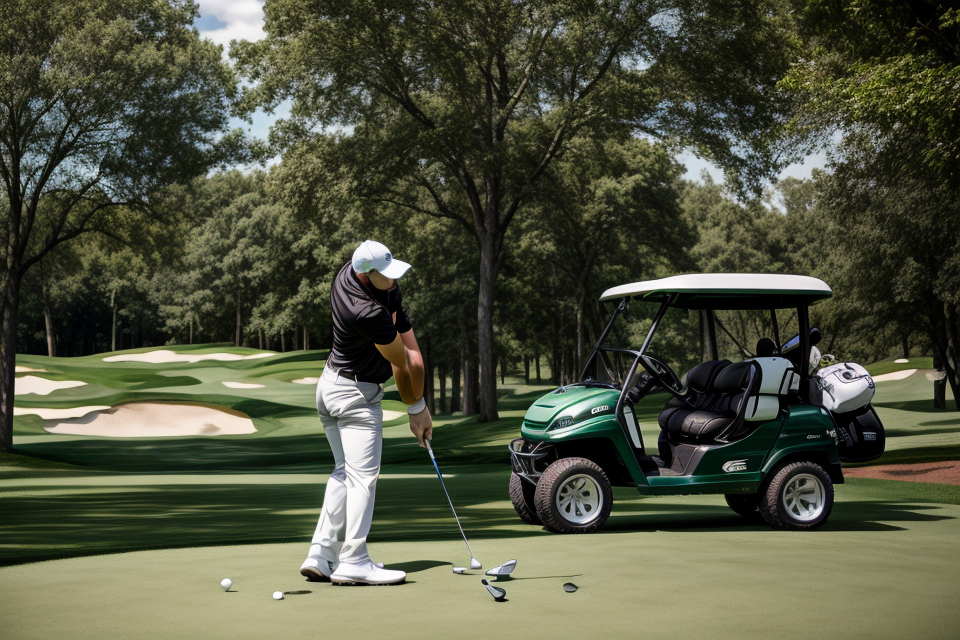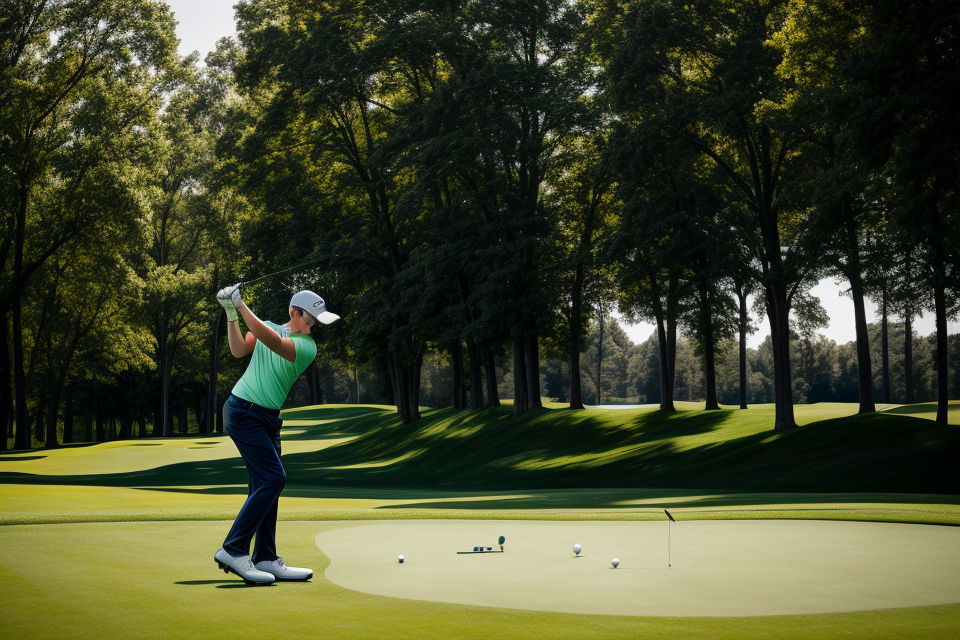
Golf is a game of precision and strategy, where every shot counts. Playing the tips in golf is a term used to describe a style of play that emphasizes taking risks and playing aggressively. This approach involves taking the ball out of the rough and attempting to hit it as close to the hole as possible, often by using lower-lofted clubs like a sand wedge or a lob wedge. While playing the tips can lead to lower scores, it also requires a higher level of skill and control. In this guide, we will explore the ins and outs of playing the tips in golf, including the benefits, risks, and techniques involved. Whether you’re a beginner or an experienced golfer, this guide will help you master the greens and improve your game.
Understanding the Basics of Playing the Tips
The Importance of Playing the Tips in Golf
Playing the tips in golf refers to the ability of a golfer to control the trajectory and spin of the ball on the green. This skill is crucial for improving accuracy and distance control, enhancing shot-making ability, and ultimately reducing score and winning golf tournaments. Here are some reasons why playing the tips is essential for any golfer:
- Improving accuracy and distance control: By playing the tips, golfers can control the ball’s trajectory and spin, allowing them to land the ball closer to the target and increase accuracy. This skill is especially important when dealing with tricky lies, such as those on undulating greens or in bunkers.
- Enhancing shot-making ability: Playing the tips involves understanding the various techniques for controlling the ball’s flight, such as lofting, spinning, and stopping the ball on a dime. Mastering these techniques can help golfers create a variety of shots, from high lobs to low chips, giving them more options around the green.
- Reducing score and winning golf tournaments: In golf, every shot counts, and playing the tips can help golfers save strokes and improve their overall score. By having more control over the ball’s flight, golfers can avoid hazards, reach the green in fewer strokes, and make more birdies. Additionally, playing the tips can give golfers an edge in tournament play, where every stroke matters.
In conclusion, playing the tips is a crucial aspect of golf that can improve a golfer’s accuracy, distance control, shot-making ability, and ultimately, their score. By mastering this skill, golfers can become more consistent and confident on the green, and ultimately, achieve greater success on the course.
Common Myths About Playing the Tips
- “Playing the tips is only for advanced golfers”
This myth is often perpetuated by those who believe that playing the tips is only for those who have mastered the game. However, this is simply not true. Playing the tips can be beneficial for golfers of all skill levels, as it allows them to improve their game by challenging themselves to play more accurately and strategically.
- “Playing the tips will result in more penalty strokes”
Another common myth about playing the tips is that it will result in more penalty strokes. While it is true that playing the tips can be riskier than playing from the fairway, it is not necessarily true that it will result in more penalty strokes. In fact, playing the tips can actually help golfers to avoid penalty strokes by encouraging them to play more strategically and avoid hazards and other obstacles on the course.
- “Playing the tips is not necessary for high-handicap golfers”
Finally, some golfers believe that playing the tips is not necessary for high-handicap golfers. However, this could not be further from the truth. In fact, playing the tips can be especially beneficial for high-handicap golfers, as it allows them to improve their game by challenging themselves to play more accurately and strategically. Additionally, playing the tips can help high-handicap golfers to improve their confidence and overall skill level on the course.
The Mechanics of Playing the Tips
Grip and Stance
Proper grip and stance are essential elements of playing the tips in golf. The grip and stance play a crucial role in the execution of shots, particularly when it comes to controlling the ball’s flight and direction. In this section, we will delve into the details of the proper grip and stance for playing the tips in golf.
Proper Grip for Playing the Tips
A proper grip is the foundation of a good golf swing. To achieve a solid grip for playing the tips, the following steps should be followed:
- Stand behind the ball: With the ball teed up, stand behind it with your feet shoulder-width apart.
- Place the hands on the club: Position the hands on the club, making sure the hands are aligned with the forearms pointing towards the ground.
- Hold the club lightly: Hold the club lightly, ensuring that the palms are facing the target.
- Grip pressure: Apply enough pressure to maintain control of the club, but not so much that it becomes uncomfortable.
Stance and Alignment for Optimal Shot-Making
The stance and alignment of the golfer are crucial factors in achieving optimal shot-making when playing the tips. To achieve the proper stance and alignment, follow these steps:
- Spine angle: Position the spine at a slight angle, allowing for a natural flow of motion during the swing.
- Feet alignment: Align the feet parallel to the target line, with the inside of the feet facing towards the target.
- Shoulders and hips: Keep the shoulders and hips square to the target line, ensuring a direct path to the ball.
- Eye line: Establish an eye line along the target line, focusing on the ball as it is addressed.
By paying close attention to the proper grip and stance, golfers can develop a solid foundation for executing shots with precision and control, especially when playing the tips in golf. Mastering these fundamental aspects of the game will help improve overall shot-making and enhance the golfer’s performance on the course.
Ball Position and Setup
When it comes to playing the tips on the golf course, one of the most important factors to consider is the position of the ball in relation to the tips. This is because the ball position can have a significant impact on the trajectory and spin of the shot, which can ultimately determine the success of the shot.
The ideal ball position for playing the tips will vary depending on the specific shot being played, as well as the golfer’s personal preference and swing mechanics. However, in general, it is recommended to position the ball slightly forward in the stance, in order to promote a smooth, controlled swing and prevent the golfer from getting too far over their feet.
In addition to ball position, the pre-shot routine is also a crucial aspect of playing the tips successfully. This includes elements such as taking a consistent, repeatable setup position, aligning the body and clubface correctly, and visualizing the desired shot shape and trajectory.
By paying close attention to ball position and following a consistent pre-shot routine, golfers can improve their ability to play the tips effectively and achieve greater success on the course.
Swing Technique
- Importance of a smooth and consistent swing
- A smooth and consistent swing is crucial to achieving accuracy and distance control on the golf course. It allows for proper weight transfer and helps to keep the clubface square through impact.
- Golfers should focus on maintaining a smooth takeaway, a controlled pause at the top of the swing, and a smooth return to the ball.
- Using the bunker play for different types of sand
- Playing out of bunkers requires a different technique than playing from the fairway or rough. Golfers should understand the different types of sand they may encounter and adjust their swing accordingly.
- For example, heavy, wet sand may require a more shallow swing, while light, fluffy sand may require a steeper angle of attack.
- Maintaining balance and body position throughout the swing
- Balance and body position are critical to a smooth and consistent swing. Golfers should focus on maintaining a stable lower body while allowing the upper body to rotate freely.
- A proper weight shift from the backswing to the downswing is also important, as it allows for proper transfer of power to the ball.
- Finally, golfers should avoid getting too tense or anxious during the swing, as this can lead to loss of balance and poor technique. Instead, they should focus on a smooth, flowing motion that allows the body to move naturally.
Playing the Tips: Tips and Tricks
Choosing the Right Club for the Shot
When it comes to playing the greens in golf, choosing the right club for the shot is crucial to achieving success. The right club can make all the difference in the world, as it can help you to hit the ball with more accuracy and distance, and ultimately, to score better. Here are some tips for choosing the right club for the shot:
Understanding the Loft and Distance of Each Club
One of the most important factors to consider when choosing a club is the loft and distance of each club. The loft of a club refers to the angle between the clubface and the plane of the swing, and it affects the trajectory and distance of the shot.
For example, a driver has a low loft, which allows the ball to travel a long distance with a high trajectory. On the other hand, a sand wedge has a high loft, which allows the ball to travel a shorter distance with a lower trajectory, making it ideal for getting out of bunkers or for making precise shots around the green.
Adjusting Club Selection Based on Course Conditions and Personal Strengths
In addition to understanding the loft and distance of each club, it’s important to adjust your club selection based on the course conditions and your personal strengths. For example, if the greens are fast and hard, you may want to use a lower lofted club to avoid digging into the turf and to keep the ball rolling faster.
On the other hand, if the greens are soft and receptive, you may want to use a higher lofted club to help the ball stop faster on the green. Additionally, if you have a tendency to slice or hook the ball, you may want to choose a club with a more neutral or draw-inducing shape to help keep your shots on the fairway.
By considering these factors and choosing the right club for the shot, you can improve your accuracy and distance, and ultimately, your score on the golf course.
Reading Greens and Adjusting Approach
Analyzing Slope, Break, and Other Green Features
When reading greens, it’s essential to consider the various features that can impact the trajectory and speed of your golf ball. Here are some factors to pay attention to:
- Slope: The angle of the green’s surface can have a significant impact on the ball’s path. A slope can cause the ball to roll towards the low point of the green or away from it. It’s crucial to understand the slope’s direction and degree to adjust your approach accordingly.
- Break: The break refers to the curve that the ball will take as it moves across the green. This curve is caused by the difference in distance that the ball travels along the green’s surface due to the change in direction. A right-to-left break means the ball will start right and curve left, while a left-to-right break means the ball will start left and curve right.
- Wind: Wind can also affect the ball’s trajectory and speed, especially when playing approach shots. Be aware of the wind’s direction and strength, as it can impact your shot selection and the distance the ball will travel.
- Elevation: Elevation changes on the green can also impact the ball’s trajectory and speed. Uphill lies can result in shorter distances, while downhill lies can lead to longer distances and more run on the ball.
Adjusting Shot Selection and Strategy Based on Green Conditions
Once you’ve analyzed the green’s features, it’s time to adjust your shot selection and strategy accordingly. Here are some tips to help you make the best decisions:
- Choose the right club: Based on the distance to the hole and the wind conditions, select the appropriate club to ensure you can control the distance and trajectory of your shot.
- Aim smart: Take into account the slope, break, and other green features when selecting your aim point. For example, if there’s a significant slope, you may need to aim at a different point on the green to account for the slope’s impact on your shot.
- Manage your trajectory: Adjust your ball position and swing to control the trajectory of your shot. This can help you avoid difficult trajectories that may be affected by slope or wind.
- Practice your chipping and pitching: Being able to control your distance and trajectory around the green is crucial for success. Practice your chipping and pitching to develop the skills needed to navigate various green conditions.
By paying close attention to the green’s features and adjusting your shot selection and strategy accordingly, you’ll be well on your way to mastering the greens and playing the tips in golf.
Mental Game and Strategy
Developing a pre-shot routine for playing the tips
- Establishing a consistent pre-shot routine to prepare for each shot
- Incorporating visualization techniques to enhance mental focus
- Utilizing physical cues, such as taking deep breaths or wagling the club, to establish a sense of calm and control
Maintaining focus and composure during crucial moments
- Staying present and focused on the task at hand
- Recognizing and managing distractions, such as outside noise or self-doubt
- Cultivating a mindset of confidence and resilience in high-pressure situations
Strategic thinking for playing the tips in different situations
- Analyzing the course layout and identifying potential challenges and opportunities
- Adapting to changing weather conditions and course conditions
- Utilizing strategic decision-making to maximize scoring potential and minimize risk
Overall, developing a strong mental game and strategy is essential for playing the tips effectively. By establishing a consistent pre-shot routine, maintaining focus and composure, and utilizing strategic thinking, golfers can enhance their ability to play the tips with confidence and precision.
Advanced Techniques for Playing the Tips
Playing from the Rough
Playing from the rough can be a challenging task for golfers of all skill levels. It requires a specific technique to ensure that the ball is accurately hit and remains on the green. Here are some tips and strategies for playing from the rough:
Proper technique for playing from rough terrain
When playing from the rough, it is important to use a lower golf swing to maintain control over the ball. The club should be held with a neutral grip, with the hands slightly ahead of the ball. This allows for a more controlled and accurate shot. It is also important to use a longer, more shallow backswing to avoid getting caught up in the thick grass.
Strategies for escaping rough and maintaining accuracy
One strategy for escaping the rough is to use a higher lofted club, such as a fairway wood or a higher numbered iron. This helps to get the ball up in the air and over any obstructions in the rough. Another strategy is to use a lower lofted club, such as a sand wedge or a lower numbered iron, to dig the ball out of the rough and keep it on the green.
It is also important to pay attention to the lie of the ball in the rough. If the ball is sitting in a patch of long grass, it may be necessary to use a more aggressive swing to cut through the grass and make solid contact with the ball. However, if the ball is sitting in a depression or on a downhill slope, it may be necessary to use a more conservative approach to avoid the ball rolling away from the green.
Overall, playing from the rough requires a combination of technique and strategy to maintain accuracy and keep the ball on the green. By using the proper technique and adapting to the lie of the ball, golfers can successfully navigate the rough and make it onto the green.
Playing from Around the Green
- Understanding the different chipping techniques for various shot distances and lies is crucial for any golfer looking to master the greens.
- For instance, when facing a short chip shot, the golfer should use a higher lofted club to get the ball airborne and land it softly on the green.
- On the other hand, when facing a longer chip shot, the golfer should use a lower lofted club to control the distance and roll of the ball.
- Additionally, it’s important to pay attention to the lie of the ball, as this can affect the trajectory and spin of the shot.
- When chipping from around the green, the golfer should focus on making solid contact with the ball and keeping the clubhead speed consistent to ensure a good result.
- Another important aspect of chipping is understanding how to use the terrain to your advantage. For example, using the slope of the green to your benefit or using the wind to help control the ball’s flight.
- Furthermore, practicing different chipping techniques and shot types is crucial to becoming proficient around the green.
- It’s also important to have a pre-shot routine, this can help to calm the golfer’s nerves and set up a good shot.
- Pitching is similar to chipping, but it is generally done from a bit farther away from the green.
- When pitching, the golfer should use a lower lofted club and focus on making a smooth, accelerating swing to get the ball airborne and land it softly on the green.
- Just like chipping, it’s important to pay attention to the lie of the ball and use the terrain to your advantage.
- It’s also important to practice different pitching techniques and shot types to become proficient at this aspect of the game.
- Using the bunker play is an important part of playing from around the green, as bunkers are often strategically placed around the green to protect par.
- When playing from a bunker, the golfer should use a lower lofted club and focus on making a smooth, accelerating swing to get the ball out of the bunker and onto the green.
- It’s important to practice different bunker play techniques and shot types to become proficient at this aspect of the game.
- The golfer should also pay attention to the type of sand in the bunker, as this can affect the trajectory and spin of the shot.
- Practicing bunker play is crucial to becoming proficient at this aspect of the game and to be able to get out of the bunker with a good result.
Advanced Putting Techniques
- Understanding green speeds and grain patterns
- Developing a consistent and accurate putting stroke
- Reading greens and adjusting approach for long and short putts
Advanced putting techniques require a deep understanding of green speeds and grain patterns. This knowledge will help golfers adjust their putting stroke to account for the different characteristics of each green. The speed of the green affects the ball’s movement, and the grain pattern determines the direction of the ball’s movement. Therefore, it is crucial to assess the green before each putt and adjust the stroke accordingly.
Developing a consistent and accurate putting stroke is essential for advanced golfers. This technique involves a smooth and rhythmic motion that allows for a consistent distance and direction of the ball. The stroke should be practiced with a light grip pressure and a straight back and through motion.
Reading greens and adjusting approach for long and short putts is another advanced putting technique. This involves analyzing the slope and curvature of the green to determine the correct line and speed of the putt. For long putts, golfers may need to adjust their stroke to account for the slope and use a more lofted golf club. For short putts, golfers should focus on making a smooth and accurate stroke with a lower lofted golf club.
In conclusion, advanced putting techniques require a deep understanding of green speeds and grain patterns, a consistent and accurate stroke, and the ability to read greens and adjust approach for long and short putts. Mastering these techniques will help golfers improve their putting and ultimately lower their scores.
FAQs
1. What does it mean to play the tips in golf?
Playing the tips in golf refers to hitting a shot from the forward tees or the tips of a golf course. This means playing from the longest distance and highest difficulty level of a golf course. Playing the tips requires a higher level of skill, precision, and technique as the course is designed to be more challenging for advanced players.
2. Why would someone choose to play the tips in golf?
Playing the tips in golf can be a challenge and an opportunity for golfers to test their skills and abilities. It can also provide a more exciting and rewarding experience for those who enjoy taking on tougher challenges. Playing the tips can also allow golfers to experience the full length and difficulty of a golf course, and to appreciate the beauty and complexity of the course’s design.
3. What are the benefits of playing the tips in golf?
Playing the tips in golf can improve a golfer’s skill and technique, as well as their overall game. It can help to build confidence and challenge players to push themselves to the next level. Playing the tips can also provide a sense of accomplishment and satisfaction, as well as a deeper appreciation for the game of golf.
4. What are the risks of playing the tips in golf?
Playing the tips in golf can be risky for players who are not skilled or experienced enough to handle the increased difficulty level. It can lead to higher scores, frustration, and even injury if players are not careful. It is important for golfers to assess their abilities and to choose a course and tees that are appropriate for their skill level.
5. How can I prepare to play the tips in golf?
To prepare to play the tips in golf, it is important to practice and develop your skills and technique. This can include practicing your driving, approach shots, and putting, as well as improving your mental and physical conditioning. It is also important to familiarize yourself with the course and to choose the right equipment for the conditions and challenges you will face.
6. What are some tips for playing the tips in golf?
Some tips for playing the tips in golf include taking your time to assess the course and plan your shots, using the appropriate equipment for the conditions, focusing on your technique and form, and managing your expectations and emotions. It is also important to stay hydrated, to eat a balanced diet, and to take breaks as needed to avoid fatigue and injury.
7. How can I improve my skills and technique for playing the tips in golf?
To improve your skills and technique for playing the tips in golf, it is important to practice regularly and to seek feedback from a golf instructor or coach. This can help you to identify areas where you need to improve and to develop a plan for making progress. It is also important to be patient and to keep practicing, even when you encounter setbacks or challenges. With time and effort, you can develop the skills and confidence you need to play the tips in golf.


